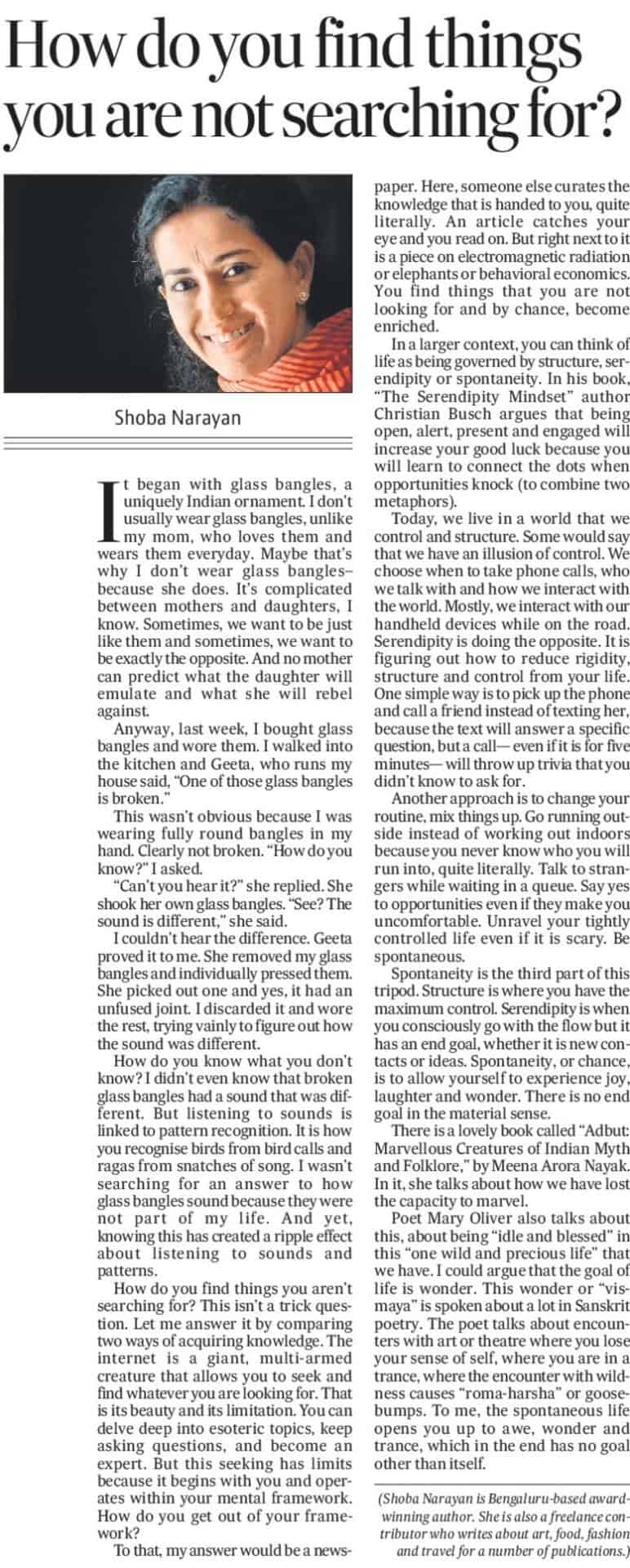It began with glass bangles, a uniquely Indian ornament. I don’t usually wear glass bangles, unlike my Mom who loves them and wears them everyday. Maybe that’s why I don’t wear glass bangles– because she does. It’s complicated between mothers and daughters, I know. Sometimes we want to be just like them and sometimes we want to be exactly the opposite. And no mother can predict what the daughter will emulate and what she will rebel against.
Anyway, last week, I bought glass bangles and wore them. I walked into the kitchen and Geeta who runs my house said, “One of those glass bangles is broken.”
This wasn’t obvious because I was wearing fully round bangles in my hand. Clearly not broken. “How do you know?” I asked.
“Can’t you hear it?” she replied. She shook her own glass bangles. “See? The sound is different,” she said.
I couldn’t hear the difference. Geeta proved it to me. She removed my glass bangles and individually pressed them. She picked out one and yes, it had an unfused joint. I discarded it and wore the rest, trying vainly to figure out how the sound was different.
How do you know what you don’t know? I didn’t even know that broken glass bangles had a sound that was different. But listening to sounds is linked to pattern recognition. It is how you recognize birds from bird calls and ragas from snatches of song. I wasn’t searching for an answer to how glass bangles sound because they were not part of my life. And yet, knowing this has created a ripple effect about listening to sounds and patterns.
How do you find things you aren’t searching for? This isn’t a trick question. Let me answer it by comparing two ways of acquiring knowledge. The internet is a giant multi-armed creature that allows you to seek and find whatever you are looking for. That is its beauty and its limitation. You can delve deep into esoteric topics, keep asking questions, and become an expert. But this seeking has limits because it begins with you and operates within your mental framework. How do you get out of your framework?
To that, my answer would be a newspaper. Here someone else curates the knowledge that is handed to you, quite literally. An article catches your eye and you read on. But right next to it is a piece on electro-magnetic radiation or elephants or behavioral economics. You find things that you are not looking for and by chance, become enriched.
In a larger context, you can think of life as being governed by structure, serendipity or spontaneity. In his book, “The Serendipity Mindset” author Christian Busch argues that being open, alert, present and engaged will increase your good luck because you will learn to connect the dots when opportunities knock (to combine two metaphors).
Today, we live in a world that we control and structure. Some would say that we have an illusion of control. We choose when to take phone calls, who we talk with and how we interact with the world. Mostly we interact with our handheld devices while on the road. Serendipity is doing the opposite. It is figuring out how to reduce rigidity, structure and control from your life. One simple way is to pick up the phone and call a friend instead of texting her, because the text will answer a specific question, but a call— even if it is for five minutes— will throw up trivia that you didn’t know to ask for.
Another approach is to change your routine, mix things up. Go running outside instead of working out indoors because you never know who you will run into, quite literally. Talk to strangers while waiting in a queue. Say yes to opportunities even if they make you uncomfortable. Unravel your tightly controlled life even if it is scary. Be spontaneous.
Spontaneity is the third part of this tripod. Structure is where you have the maximum control. Serendipity is when you consciously go with the flow but it has an end goal, whether it is new contacts or ideas. Spontaneity or chance is to allow yourself to experience joy, laughter and wonder. There is no end goal in the material sense.
There is a lovely book called “Adbut: Marvellous Creatures of Indian Myth and Folklore,” by Meena Arora Nayak. In it, she talks about how we have lost the capacity to marvel. Poet Mary Oliver also talks about this, about being “idle and blessed” in this “one wild and precious life” that we have. I could argue that the goal of life is wonder. This wonder or “vismaya” is spoken about a lot in Sanskrit poetry. The poet talks about encounters with art or theatre where you lose your sense of self, where you are in a trance, where the encounter with wildness causes “roma-harsha” or goosebumps.






Leave A Comment